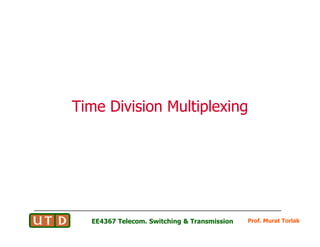Time division
•
0 likes•267 views
Time Division Multiplexing (TDM) can operate synchronously or asynchronously. TDM structures include bit interleaving and word interleaving. The E1 and T1 systems use different coding and have different frame sizes, with E1 providing 2.048 Mbps bandwidth and T1 providing 1.544 Mbps bandwidth. Framing establishes synchronization by adding bits or channels and can be lost due to sample clock slip or channel errors. Added-digit framing inserts alternating framing bits, while added-channel framing establishes an extra channel for framing.
Report
Share
Report
Share
Download to read offline

Recommended
Recommended
More Related Content
What's hot
What's hot (20)
Viewers also liked
Viewers also liked (20)
Multiplexing and switching(TDM ,FDM, Data gram, circuit switching)

Multiplexing and switching(TDM ,FDM, Data gram, circuit switching)
Similar to Time division
Similar to Time division (20)
Multiband Transceivers - [Chapter 3] Basic Concept of Comm. Systems![Multiband Transceivers - [Chapter 3] Basic Concept of Comm. Systems](data:image/gif;base64,R0lGODlhAQABAIAAAAAAAP///yH5BAEAAAAALAAAAAABAAEAAAIBRAA7)
![Multiband Transceivers - [Chapter 3] Basic Concept of Comm. Systems](data:image/gif;base64,R0lGODlhAQABAIAAAAAAAP///yH5BAEAAAAALAAAAAABAAEAAAIBRAA7)
Multiband Transceivers - [Chapter 3] Basic Concept of Comm. Systems
Implementation of MIL-STD1553 using Microcontroller Atmega 328P

Implementation of MIL-STD1553 using Microcontroller Atmega 328P
The history of synchronisation in digital cellular networks

The history of synchronisation in digital cellular networks
Channel Estimation In The STTC For OFDM Using MIMO With 4G System

Channel Estimation In The STTC For OFDM Using MIMO With 4G System
Recently uploaded
Recently uploaded (20)
HOA1&2 - Module 3 - PREHISTORCI ARCHITECTURE OF KERALA.pptx

HOA1&2 - Module 3 - PREHISTORCI ARCHITECTURE OF KERALA.pptx
Unit 4_Part 1 CSE2001 Exception Handling and Function Template and Class Temp...

Unit 4_Part 1 CSE2001 Exception Handling and Function Template and Class Temp...
PE 459 LECTURE 2- natural gas basic concepts and properties

PE 459 LECTURE 2- natural gas basic concepts and properties
Standard vs Custom Battery Packs - Decoding the Power Play

Standard vs Custom Battery Packs - Decoding the Power Play
1_Introduction + EAM Vocabulary + how to navigate in EAM.pdf

1_Introduction + EAM Vocabulary + how to navigate in EAM.pdf
A CASE STUDY ON CERAMIC INDUSTRY OF BANGLADESH.pptx

A CASE STUDY ON CERAMIC INDUSTRY OF BANGLADESH.pptx
Orlando’s Arnold Palmer Hospital Layout Strategy-1.pptx

Orlando’s Arnold Palmer Hospital Layout Strategy-1.pptx
Double Revolving field theory-how the rotor develops torque

Double Revolving field theory-how the rotor develops torque
Time division
- 1. Time Division MultiplexingTime Division Multiplexing Prof. Murat TorlakEE4367 Telecom. Switching & Transmission
- 2. Basic Modes of OperationBasic Modes of Operation TDM Modes Synchronous Mode: repeatedly assigning the transmission channel. Ex: STDM (circuit switching) Asynchronous Mode: as needed, Ex: ATDM, ATM, Stat-Mux (packet switching) TDM structures Bit interleaving: single bit Prof. Murat TorlakEE4367 Telecom. Switching & Transmission Bit interleaving: single bit Word Interleaving: larger number of bits (word-length)
- 3. E1/T1 DifferenceE1/T1 Difference The E1 system is dominant in Europe and some non-Europe countries. The T1 system is dominant in USA, Canada and Japan. E1 and T1 use the same sampling frequency (8 kHz), PCM frame length (125 ms), bits per code (8 bits) and timeslot bit rate (64 kbps). They differ in these aspects: E1 adopts A law coding/decoding of 13-segment but T1 adopts Prof. Murat Torlak E1 adopts A law coding/decoding of 13-segment but T1 adopts m law coding/decoding of 15-segment. Each PCM primary frame of E1 contains 32 timeslots but T1’s contains 24 timeslots. Each PCM primary frame of E1 contains 256 bits but T1’s contains 193 bits. Therefore, E1 provides 2.048 Mbps bandwidth but T1 provides 1.544 Mbps bandwidth. EE4367 Telecom. Switching & Transmission
- 4. FramingFraming To identify individual time slots Overhead bits are required to establish frame synchronization Basic means of establishing frame synchronization Added-bit Added-channel Unique line signal Statistical Prof. Murat TorlakEE4367 Telecom. Switching & Transmission Statistical Loss of framing implies a loss of data on all channels Reframing time and frequency of accourance Source of out of frame conditions Sample clock may lose synchronization with the line clock and produce a slip in the counter sequence Channel errors. To prevent channel errors high redundancy in framing patter is needed.
- 5. AddedAdded--Digit FramingDigit Framing Periodically interting a framing bit with a identifiable data sequence. Added once for every frame and alternates in value. It is used D1 channel banks. Frame length is 193 bit in D1 channel banks. Framing is established in a receiving D1 channel bank by monitoring first one bit position within a 193-bit frame and Prof. Murat TorlakEE4367 Telecom. Switching & Transmission monitoring first one bit position within a 193-bit frame and then another, until the alternating pattern is located. With this framing strategy, the expected framing time from a random starting point with random date is given as Frame Time=N2+N/2 bit times where N is the number of bits in a frame time N=193 the framing time is 37,346 bits or 24.188msec
- 6. AddedAdded--Digit FramingDigit Framing Prof. Murat TorlakEE4367 Telecom. Switching & Transmission
- 7. AddedAdded--Channel FramingChannel Framing Frame digits are added in a group such that an extra channel is established The E1 standard (ITU) uses 32 channels per frame. One timeslot is reserved for framing purposes, and alternately transmits a fixed pattern. This allows the receiver to lock onto the start of each frame and match up each channel in turn. Prof. Murat TorlakEE4367 Telecom. Switching & Transmission each channel in turn. FAS: Frame alignment signal Another channel is used for signaling. L is the length of the frame code E1: N=512 and L=7 0.5 msec, much faster than DS1 added- digit frame times